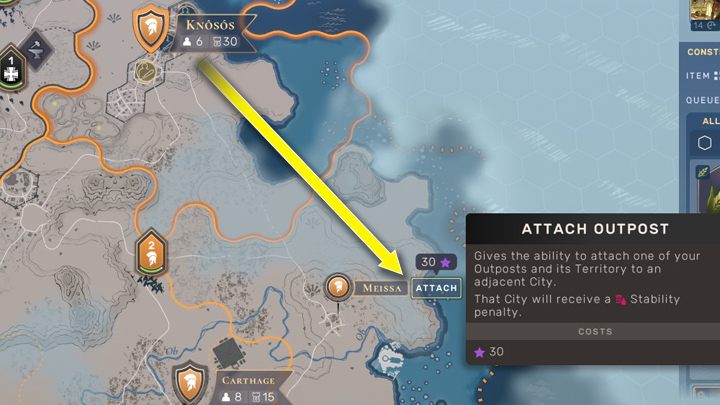Humankind: Territory - how to connect with the city? Humankind guide, tips
In this part of the Humankind game guide there are descriptions of territories, how to conquer new territories and how to combine them with cities.
Last update: 06 September 2021
This page of our guide to Humankind describes territories and how to connect them with the cities.
An unconnected outpost is not fully a part of your empire! Independent tribes can take it. Also, other nations with which you do not have a signed non-aggression pact can attack units and outposts in such territory. Only the connection of the region with any city of your nation makes it fully a part of the state. From now on, the other players must either sign an open-borders agreement with you or declare war on you.

- Costs and rules of connecting the territory with the city
- Advantages of adding new regions to the city
- Disadvantages of adding territories into the same city
Costs and rules of connecting the territory with the city
Connecting the territory to the city requires Influence points. The first connection costs only 30 points, but the more connected regions a city has, the higher the cost. From now on, the outpost turns into an Administrative Center and now yields bonuses for infrastructure improvements. After connecting the region with the city, you can build new districts not only in the vicinity of your city, but also next to the Administrative Center.

There are several rules that modify the costs associated with the acquisition and annexation of territories. This will make your expansion a little cheaper, and that means you can conquer more regions in less time. It is worth doing the following, before building new outposts and incorporating new territories:
- Legitimacy: Customary Law - reduces the Outpost cost by 50%. In the early eras of the game, it is useful, when you focus on expansions. This will facilitate the acquisition of many new territories in a short time.
- Legitimacy: codified law (Legitimacy: Codified Laws)- connecting the Outpost to the city is cheaper by 20%. It is worth changing this rule after you occupy all possible territories. This way, adding new districts to the city will be cheaper.
- Land Rights: Inherited Land - this is an extremely useful law, because it will allow the joining, merging and absorption of territories and cities using funds instead of Influence. In this way, you will be able to pay in gold, and you will leave the Influence for other expenses. This is an extremely useful law, especially if you are running merchant cultures. Then you usually have more funds than Influence, so you can spend the surplus in this way.
The merging of territories is an inevitable part of the development of your empire. You have to decide if, how much, when, and which territories to connect with the city. Optimally, each city should have 1 to 3 regions attached (if you control a large area). A large number of territories have a positive effect on the economy, but the siege of the city itself blocks production and stops the training of units. Remember that adding a territory to the city has its pros as well as cons!

In each game you have to find the happy medium between a large number of small towns and combining all the territories into one big city. Usually it all comes down to the amount of controlled territories and the amount of Influence in your account. If the area is large and you have few points of influence, then you should build fewer cities, but with more connected areas. On the other hand, if there is little room for development, it is better to build more cities at the expense of connecting regions to the existing ones. It is worth paying attention to the list below and evaluate whether the pros are more favorable than the potential disadvantages.
Advantages of adding new regions to the city
- Population points from the Outpost are passed to the city, and all collected revenue from this region counts towards the city revenue (very useful at the beginning of the game).
- The territory becomes a full part of the nation and other players must respect your boundaries.
- The city gains new areas for development.
- Strategic and luxury resources are better protected.
- You can build additional garrisons in vulnerable parts of the territory and strengthen defensive positions.
- The construction of additional ports and railway stations will facilitate the transport of vessels and goods.
- Infrastructure in the city affects all connected regions. For example Irrigation, provides 2 food points for each field with a river for all territories connected to the city.
- The boundaries of the territories no longer matter to the districts, which previously could not collect raw materials from neighboring fields of another territory.
Disadvantages of adding territories into the same city
- Cost of connecting more and more territories means more and more points of influence (the cost of connecting cities is also higher).
- Each added territory results in -20 stability points! If you add too many regions, your city will stop working.
- Districts that become part of the city increase the cost of new district. The addition of developed territories can slow down the development of the city. On the other hand, you can just shut down the city for a while.
- The occupation of the city means the loss of control over all territories (although at the signing of peace may demand only some, if not enough points of War Support).
- The Administrative Center is not protected by walls. Connection it directly with the city will increase the level of defense (the city and the administrative center must be connected by districts)
- The administration center can still be destroyed by the enemy! This can take place together with looting, artillery shelling, bombing, missile or nuclear attack. In this case, the territory becomes no one's territory, and if other territories do not have a connection to your city, they are automatically disconnected.
